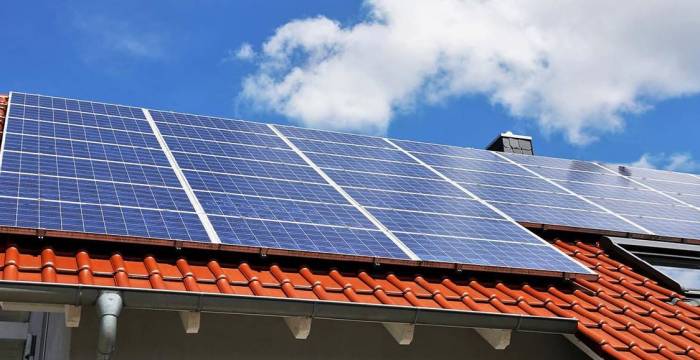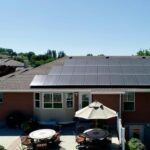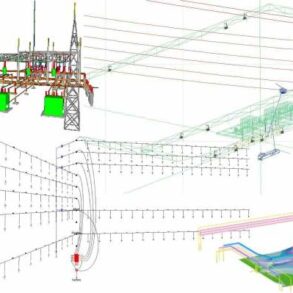How to make sure your solar panels last for decades sets the stage for this insightful guide, offering a roadmap to maximize their lifespan. We’ll delve into crucial factors, from selecting the right panels and installation techniques to understanding environmental impacts and ongoing maintenance. Learn how to monitor your panels, stay ahead of potential issues, and leverage the latest technological advancements to ensure your investment in solar power provides decades of reliable energy.
From the initial panel selection to the ongoing maintenance and future-proofing strategies, this guide covers every essential aspect of solar panel longevity. We’ll explore the critical factors impacting your solar panels’ lifespan, equipping you with the knowledge to make informed decisions and safeguard your investment. Choosing the right panels, ensuring proper installation, and mitigating environmental risks will be discussed in detail.
Panel Selection and Installation
Choosing the right solar panels and ensuring their proper installation are crucial for maximizing longevity and performance. A well-considered approach to panel selection, installation, and maintenance will translate to years of reliable energy production. A crucial step in this process is recognizing the long-term impact of each decision, from the initial panel purchase to the final connection to your home’s electrical system.
Factors to Consider When Choosing Solar Panels
Selecting the appropriate solar panels involves careful consideration of several factors. Panel efficiency, measured in percentage, directly correlates to the amount of sunlight converted into electricity. Higher efficiency panels produce more power per square meter, potentially reducing the overall system size needed. Panel wattage and the total system size will be determined by the expected energy demands of your home.
Consider the panel’s warranty duration, which often indicates the manufacturer’s confidence in its longevity. Materials used in the panel’s construction are critical. High-quality materials, including durable glass and robust frames, increase the panel’s resistance to environmental stressors like hail, wind, and temperature fluctuations, leading to a longer lifespan.
Importance of Proper Panel Installation Techniques
Proper installation techniques are paramount for the long-term health and performance of your solar panel system. Mishandling or incorrect mounting can lead to premature failure. This includes ensuring the panels are properly secured to the mounting system, preventing any potential stress points that might lead to cracks or breakage. Proper alignment with the sun’s path maximizes energy production and ensures the system operates efficiently throughout the year.
Keeping your solar panels in tip-top shape for years to come involves a few key strategies, like regular maintenance and careful installation. Proper cleaning and ensuring optimal panel alignment are crucial. Thinking about the longevity of your investment, and the impact it has on the planet, is key. Speaking of long-term projects, I’ve been diving deep into the fascinating world of retro gaming lately, particularly the enduring appeal of classic games like Tetris.
If you’re interested in a fun exploration of how pixelated nostalgia can inspire new approaches to technology, check out my latest post on lets do the tetris time warp again. Ultimately, maximizing your solar panel lifespan requires a combination of proactive care and a bit of strategic planning.
The correct electrical connections are essential for preventing electrical issues and ensuring the safety of the system.
Different Types of Mounting Systems
Various mounting systems exist, each with its impact on panel longevity. Ground-mounted systems are often suitable for large-scale installations and offer flexibility in alignment with the sun’s path. Roof-mounted systems are common for residential applications and require careful consideration of roof load capacity and panel orientation to maximize performance. The type of mounting system will affect the lifespan of the solar panel system.
Ensuring your solar panels last for decades involves more than just installation. Regular maintenance, like cleaning and checking for damage, is key. And while exploring the latest tech, like the Polygon Ayaneo 3, polygon ayaneo 3 hands on , can be fascinating, remembering to prioritize proper panel care is essential for long-term sustainability. Ultimately, a proactive approach to solar panel upkeep will maximize their lifespan and generate consistent power for years to come.
A well-engineered and professionally installed mounting system can withstand extreme weather conditions, contributing significantly to the panel’s overall longevity.
Pre-Installation Site Assessment
A thorough site assessment is crucial for determining the optimal location and configuration of your solar panel system. The assessment must consider factors like roof slope, shading, and the angle of the sun. This crucial step ensures the panels are positioned to maximize energy generation. The assessment also needs to identify potential obstacles or issues, like trees or other structures that might cast shadows on the panels.
A proper site assessment will help avoid problems later and contribute to the overall longevity of the system.
Selecting Qualified Installers
Selecting qualified installers is essential for ensuring a high-quality installation. Check references and certifications. A reputable installer will have experience in installing various types of systems and the required certifications to perform the installation. This will give you a greater sense of confidence in their expertise and the longevity of the installation. Look for installers with experience in handling similar climates and weather conditions to avoid problems.
Comparison of Panel Types
| Panel Type | Durability | Lifespan (Estimated) | Additional Notes |
|---|---|---|---|
| Monocrystalline | High | 25-30 years | Known for efficiency and high power output. |
| Polycrystalline | Medium | 20-25 years | More affordable than monocrystalline. |
| Thin-Film | Lower | 15-20 years | Generally less expensive and suitable for specific applications. |
Panel durability and lifespan can vary based on factors such as manufacturing quality, installation techniques, and environmental conditions. This table provides a general overview and should not be considered a definitive guarantee. Consult with experts for specific recommendations.
Environmental Factors and Maintenance
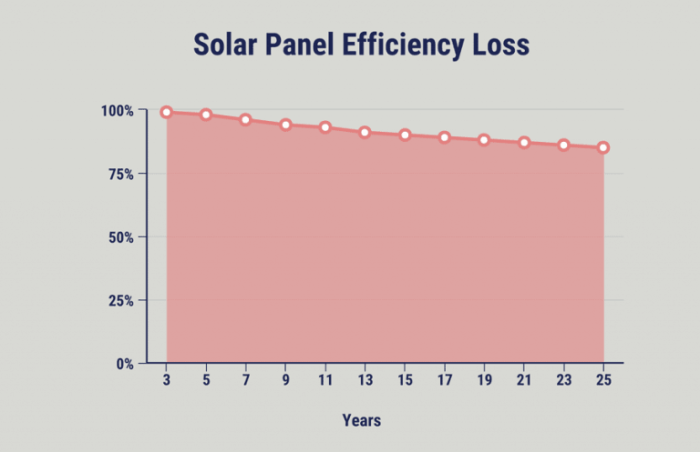
Solar panels, while remarkably efficient, are not immune to the elements. Understanding how environmental factors impact their performance is crucial for maximizing their lifespan and ensuring optimal energy production. Proper maintenance plays a vital role in preserving the integrity of your solar investment, allowing it to continue delivering its promise for decades.
Key Environmental Factors Affecting Solar Panel Degradation
Environmental conditions significantly influence solar panel performance and lifespan. Factors like temperature fluctuations, humidity, and, most importantly, extreme weather events can cause stress and damage to the panels. Sunlight itself, though essential for energy generation, can also lead to some degradation over time through photo-degradation, a process that affects the performance of the panel.
Impact of Extreme Weather Conditions
Hailstorms, heavy snowfall, and high winds can severely impact solar panel performance and longevity. Hailstones can cause physical damage, creating cracks or dents that reduce efficiency and even lead to panel failure. Snow accumulation can also hinder the panel’s ability to absorb sunlight, reducing energy output. Strong winds can dislodge mounting structures or damage the panels themselves, causing structural damage or breakage.
Protecting Panels from Environmental Hazards, How to make sure your solar panels last for decades
Implementing preventative measures is key to protecting solar panels from environmental hazards. Properly designed mounting structures that can withstand high winds and snow loads are essential. Using protective covers during extreme weather conditions, particularly during hailstorms or heavy snowfall, can significantly reduce the risk of damage. Regular inspections can help identify any early signs of damage or stress on the panels.
Keeping your solar panels in tip-top shape for years to come involves regular maintenance and smart purchasing decisions. One important aspect of long-term investment is understanding the current market value of similar products, like checking out nikon coolpix w300 camera price comparison to get a sense of the going rate for comparable equipment. Ultimately, a well-maintained system, coupled with high-quality components, is key to ensuring your solar panels last for decades.
Regular Maintenance Schedule
A consistent maintenance schedule is crucial for ensuring the long-term performance of solar panels. Regular cleaning is paramount, as dust, debris, and dirt accumulation can significantly reduce the amount of sunlight absorbed by the panels. This, in turn, lowers energy output.
Cleaning and Inspection Frequency
Regular cleaning and inspection are vital components of a preventative maintenance strategy. Dust and debris buildup can reduce energy production by as much as 15% or more. Therefore, cleaning and inspection should be performed at least twice a year, or more frequently depending on the local environment. A detailed inspection should include checking for any physical damage, such as cracks, dents, or loose connections, ensuring the mounting structure is secure and the panels are properly aligned.
Table of Common Environmental Risks and Mitigation Strategies
| Environmental Risk | Mitigation Strategy |
|---|---|
| Hail | Use protective covers during hailstorms. Select panels with reinforced construction |
| Snow | Ensure proper mounting structure design that can handle snow loads. Regularly clear snow from panels |
| High Winds | Use high-strength mounting systems designed for the local wind conditions. Secure all connections and components. |
| Dust and Debris | Schedule regular cleaning to remove dust and debris buildup. Consider using specialized cleaning solutions. |
| Temperature Fluctuations | Select panels optimized for the local temperature range. |
Panel Monitoring and Diagnostics
Keeping tabs on your solar panels’ performance is crucial for maximizing their lifespan and energy output. Regular monitoring allows you to identify potential issues early, preventing significant damage and ensuring optimal energy production. This proactive approach translates to significant long-term cost savings and peace of mind.Proactive monitoring goes beyond just occasional visual inspections. Sophisticated systems track key performance indicators (KPIs), allowing you to pinpoint the root cause of any performance degradation before it becomes a major problem.
This empowers you to take timely corrective actions, maintaining high efficiency and extending the operational life of your solar panels.
Methods for Monitoring Panel Performance
Monitoring panel performance involves tracking various key metrics. These metrics include voltage, current, power output, temperature, and incident solar radiation. Accurate data collection from these parameters allows for precise analysis of panel health and efficiency. Monitoring systems, both standalone and integrated into larger energy management systems, offer valuable insights into panel performance trends.
Diagnostic Tools for Identifying Potential Issues
Several diagnostic tools can be employed to identify potential problems early. These include advanced sensors, data loggers, and software applications specifically designed for solar panel monitoring. These tools collect and process real-time data, providing a detailed picture of panel performance, enabling rapid detection of anomalies and early intervention. Modern systems often provide predictive maintenance capabilities, forecasting potential failures and guiding proactive repairs.
Interpreting Data from Monitoring Systems
Interpreting data from monitoring systems requires understanding the specific parameters being tracked and the typical performance characteristics of your solar panels. Analyzing trends in voltage, current, and power output over time is critical. Deviation from expected patterns might indicate issues such as shading, dirt buildup, or panel degradation. Detailed analysis of temperature data helps identify overheating issues, which can lead to reduced efficiency and potential damage.
Troubleshooting Common Issues
A step-by-step troubleshooting guide is essential for addressing common issues. The first step involves examining visual inspection for obvious signs of damage or obstruction. Second, assess data logs for anomalies in performance metrics. Third, use diagnostic tools to pinpoint the source of the problem. If the problem is related to shading, consider relocation or adjustment of the panel’s orientation.
If dirt or debris is the cause, consider implementing a cleaning schedule. If the problem is due to a manufacturing defect or panel degradation, professional assessment might be required.
Examples of Monitoring and Diagnostic Technologies
Numerous technologies are employed for monitoring and diagnostics. These include smart inverters that monitor panel performance and provide real-time data, specialized sensors that measure panel temperature and output, and cloud-based monitoring platforms that provide centralized data visualization and analysis. Furthermore, machine learning algorithms can be incorporated into monitoring systems to predict potential failures and suggest preventive maintenance measures.
Comparison of Monitoring Systems
| Monitoring System | Features | Cost |
|---|---|---|
| Standalone Data Logger | Basic data logging, visual display | Low |
| Smart Inverter with Monitoring | Real-time data, basic analysis, integration | Medium |
| Cloud-Based Monitoring Platform | Advanced analysis, remote access, predictive maintenance | High |
Technological Advancements and Future Trends: How To Make Sure Your Solar Panels Last For Decades
The quest for ever-improving solar panel technology is a continuous journey, driven by the need for more efficient energy capture and longer lifespans. Constant research and development are pushing the boundaries of what’s possible, promising significant advancements in the years to come. These advancements will not only improve the performance of existing systems but also unlock new possibilities for integrating solar energy into diverse applications.The evolution of solar panel technology is inextricably linked to the progress in materials science and engineering.
New materials are being explored and developed to enhance light absorption, reduce manufacturing costs, and increase durability. Understanding these trends is critical to predicting the future of solar energy and maximizing the return on investment for solar panel installations.
Impact of Material Advancements on Longevity
Material advancements are directly impacting the longevity of solar panels. Transitioning from traditional silicon-based panels to newer, more efficient materials is a key driver of this progress. Perovskites, for instance, exhibit a higher power conversion efficiency, potentially reducing the overall panel size needed for a given power output. This, in turn, can lead to lighter, more aesthetically pleasing designs, and potentially lower manufacturing costs.
The use of advanced polymers and coatings in panel construction enhances resistance to environmental stresses like temperature fluctuations, humidity, and mechanical impacts. This increased resilience translates into a longer operational lifespan.
Comparison of Current and Future Solar Panel Technologies
Current silicon-based solar panels, while proven and reliable, are constantly being refined. Improvements focus on enhancing light absorption, reducing energy losses during conversion, and increasing the efficiency of the silicon cells. Emerging technologies, such as tandem solar cells, which combine different materials to capture a wider spectrum of sunlight, are poised to significantly increase efficiency. Organic solar cells, leveraging organic polymers, are another promising area, offering potentially lower manufacturing costs and flexibility in design.
These advancements, while not yet widespread, suggest a potential shift in the solar panel landscape, with higher efficiency and potentially lower production costs becoming the norm.
Emerging Trends and Their Impact on Durability
Emerging trends in solar panel design, while promising, can also pose challenges to long-term durability. The increasing use of flexible solar panels, for instance, introduces new mechanical stress factors that need careful consideration. The integration of solar panels into building facades and other architectural elements necessitates robust designs capable of withstanding various weather conditions. The need for better heat management in high-temperature environments is crucial for ensuring longevity.
The rapid evolution of these technologies underscores the importance of ongoing research and testing to ensure both performance and durability are maintained.
Role of Research and Development in Future Lifespan
Research and development are instrumental in driving the future lifespan of solar panels. Ongoing innovation focuses on improving the efficiency and durability of existing materials. This includes exploring new silicon alloys, developing more robust encapsulation methods, and optimizing manufacturing processes to reduce defects and increase yield. The continuous push for improved performance and durability, through advanced materials and design, promises a significant increase in the lifespan of future solar panels.
Ongoing Innovation in Solar Panel Performance and Resilience
Ongoing innovation in solar panel technology is continuously improving both performance and resilience. The development of new materials, like high-efficiency perovskites and advanced polymers, leads to more efficient energy conversion and increased resistance to degradation. Sophisticated monitoring systems, coupled with predictive maintenance models, allow for proactive identification of potential issues, reducing downtime and extending panel lifespan. These advancements are expected to continue driving down the cost of solar energy and improve its reliability.
Table: Evolution of Solar Panel Technology
| Technology | Material | Efficiency (estimated) | Lifespan (estimated) | Expected Improvements |
|---|---|---|---|---|
| Crystalline Silicon (Current) | Silicon | 15-22% | 25-30 years | Higher efficiency, reduced manufacturing costs |
| Perovskite Solar Cells (Emerging) | Perovskite | 20-25% | 20-25 years | Increased efficiency, flexibility, potential for lower costs |
| Tandem Solar Cells (Future) | Multiple materials | 30%+ | 25-35 years | Higher efficiency, potentially more cost-effective than current silicon |
Warranty and Insurance Considerations
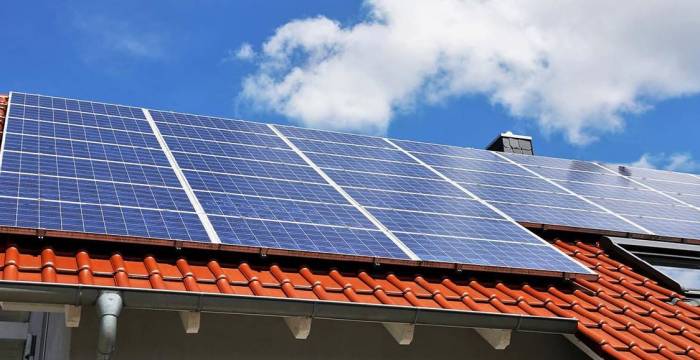
Protecting your solar panel investment requires a proactive approach beyond just installation. Understanding the terms and limitations of manufacturer warranties, coupled with suitable insurance coverage, is crucial for long-term peace of mind. A well-defined strategy safeguards against unexpected issues and ensures your system continues to generate clean energy for decades.
Understanding Manufacturer Warranties
Manufacturer warranties are essential documents outlining the extent of the manufacturer’s responsibility for defects in materials and workmanship. These warranties typically cover components like panels, inverters, and mounting structures, but the scope and duration vary significantly. Understanding the specific terms and conditions is vital. A warranty may cover defects in materials or workmanship, but not damage from environmental factors like hail or fire.
Read the fine print carefully, noting any exclusions or limitations, like the specific circumstances under which the warranty is not applicable. This includes understanding what constitutes “normal wear and tear.”
Warranty Limitations and Exclusions
Warranties often have limitations. These may include exclusions for damage caused by misuse, negligence, or acts of God. For example, a warranty might not cover damage from a severe storm if the system was not properly secured. Another key consideration is the specific coverage period for different components. The inverter, which converts DC power to AC, might have a shorter warranty than the solar panels themselves.
Insurance Options for Solar Panels
Insurance options can provide additional layers of protection beyond manufacturer warranties. This is particularly valuable for covering damage from unforeseen events, such as storms, vandalism, or fire. Homeowners insurance policies may or may not include solar panel coverage. Check your current policy or consult with your insurer to determine if solar panel protection is included. If not, specialized solar panel insurance policies may be available.
Factors to Consider When Evaluating Warranties
- Coverage duration: Evaluate the length of the warranty and the coverage period for different components. Compare warranties to ensure you have comprehensive coverage for your system.
- Exclusions: Carefully review the exclusions listed in the warranty. Understanding what isn’t covered is just as important as knowing what is covered. Look for warranties that specifically address damage from weather events.
- Claim process: Ensure the claim process is straightforward and efficient. Consider the steps required to file a claim and the timeframe for resolution. Read reviews from other customers who have used the warranty.
- Reputation of the manufacturer: Research the reputation of the manufacturer and their history with warranty claims. Look for companies with a strong track record of resolving issues fairly.
Choosing a Reputable Insurance Provider
Choosing a reputable insurance provider is crucial for effective coverage. Look for companies with a strong financial standing and a history of fulfilling claims. Read online reviews and compare policies from different providers. Contact several providers and ask specific questions about solar panel coverage to assess the level of expertise and support.
Examples of Successful Claims and How to Make a Claim
“A homeowner whose panels were damaged during a hail storm successfully filed a claim with their solar panel insurance provider, receiving prompt compensation for the repairs.”
To make a claim, follow the instructions provided by your insurance provider. Gather all necessary documentation, including photos of the damage and proof of purchase. Be clear and concise in describing the issue. Communicate promptly with your insurance provider throughout the claims process.
Warranty Comparison Table
| Warranty Provider | Coverage Duration (Years) | Coverage for Hail Damage | Coverage for Fire Damage | Claim Process Complexity |
|---|---|---|---|---|
| Company A | 25 | Yes | Yes | Simple |
| Company B | 20 | No | Yes | Moderate |
| Company C | 15 | Yes | No | Complex |
Ending Remarks
In conclusion, ensuring the longevity of your solar panels involves a multi-faceted approach. By carefully considering panel selection, installation, environmental factors, proactive maintenance, and staying updated on technological advancements, you can significantly extend their operational life. Understanding warranties and insurance options provides further layers of protection. Ultimately, a comprehensive strategy will allow you to harness the power of solar energy for decades to come, securing a sustainable and reliable energy source for years to come.



